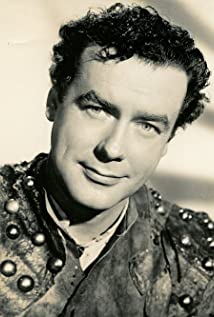Richard Greene
Before achieving his greatest fame in the 1950s as television's "Robin Hood", handsome Richard Greene had a significant if largely unremarkable film career, turning in several skillful leading man performances in the late 1930s before becoming type-cast in routine costume adventures. Like his friendly rival, Tyrone Power, Greene's good looks aided his entry into films but ultimately proved detrimental to his development as a film actor.
A descendant of four generations of film actors, and a grandson of film pioneer William Friese-Greene, Richard Marius Joseph Greene seemed destined for a career as a movie actor. Born August 25, 1918 (Some sources list his birth-date as 1914) in the port city of Plymouth, Devonshire, England, Greene was educated at the Cardinal Vaughn School in Kensington. At an early age, he became determined to pursue the acting profession, making his stage debut in 1933 at the Old Vic as a spear carrier in a production of William Shakespeare's "Julius Caesar". By this time, the formerly gawky teenager was rapidly maturing into an exceedingly good-looking young man with an athletic build, dark wavy hair, and a pleasant speaking voice. So handsome was he that in between acting gigs, he supplanted his income as a shirt and hat model.
After a small role in a 1934 revival of "Journey's End and a bit part in the British musical film, Sing As We Go! (1934), Greene joined the Brandon Thomas Repertory Company in 1936, travelling the length and breadth of the British Isles in a variety of productions. His first major break came in 1936 when he won accolades on the London stage as the juvenile lead in Terence Rattigan's "French Without Tears", which brought him to the attention of Alexander Korda then Darryl F. Zanuck. Fox signed the youngster in January, 1938, brought him to America, and immediately cast him in his first film: as the youngest of four brothers in John Ford's Four Men and a Prayer (1938). His excellent reviews and camera-friendly physical appearance (which inspired mountains of fan mail from adoring feminine moviegoers) convinced Zanuck to rush Greene into a series of top-notch films which showed him to advantage, and might have been the springboard to more substantive roles and super-stardom had fate and World War II not intervened.
Greene gave several notable performances as a Fox contractor. He was a banker's son-turned-horse trainer in the popular horse-breeding epic, Kentucky (1938), a murdered baronet's son in the eerie "Sherlock Holmes" mystery, The Hound of the Baskervilles (1939), a college student estranged from his alcoholic father in Here I Am a Stranger (1939), and steamboat inventor Robert Fulton in the fanciful historical drama, Little Old New York (1940). At the peak of his popularity, with a growing resume of critically-acclaimed film work, and fan mail rivaling Fox's number one heartthrob, Tyrone Power, Greene abandoned his studio contract in 1940 and returned to his homeland to aid in the war effort: an admirable personal decision which would have negative professional consequences. Enlisting in the Royal Armoured Corps of the Twenty-Seventh Lancers, he distinguished himself throughout World War II, eventually becoming a captain. He was discharged in December, 1944. During the war, he was given three furloughs to appear in British propaganda features. After the conflict ended, Greene and his young bride, beautiful British actress, Patricia Medina (whom he married in 1941) remained in England for a time, where both appeared on stage and in British movies. Richard's films included the charming comedy, Don't Take It to Heart! (1944), and the disappointing biopic, Showtime (1946 In 1946, the ambitious Greene (accompanied by his wife who'd been offered a Fox contract) returned to Hollywood hoping to take up where he'd left off. When his dreams of regaining his lost momentum did not materialize,

